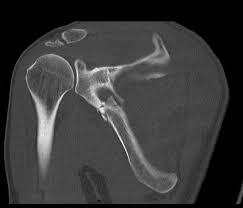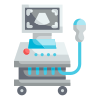Fill out form to enquire now
CT For Scapula
Medintu has collaborated with the best pathology laboratories that are NABL and NABH certified and follow ISO safety guidelines to provide the best CT For Scapula at an affordable price for needy individuals. The scapula, or shoulder blade, plays a crucial role in the movement and stability of the shoulder. It serves as the attachment point for muscles and ligaments that allow for the wide range of motion in the arm. However, injuries or conditions affecting the scapula—such as fractures, dislocations, tumors, or infections—can cause significant pain and dysfunction. When a detailed assessment is needed to evaluate these issues, a CT scan (Computed Tomography scan) is often the most effective imaging technique. A CT scan for the scapula provides high-resolution, cross-sectional images of the bone and surrounding tissues, allowing healthcare professionals to identify and diagnose conditions that may not be visible with traditional X-rays. This advanced imaging method combines the power of X-rays and computer technology to produce detailed, 3D images, offering greater clarity and accuracy for diagnosing shoulder and upper back injuries. Whether it’s to assess a shoulder injury, detect fractures, or evaluate soft tissue involvement, a CT scan is a non-invasive, quick, and reliable diagnostic tool that plays an essential role in determining the best course of treatment. In this section, we’ll explore why a CT scan is used for the scapula, how the procedure works, and what you can expect during and after the scan.
To schedule an appointment for a CT For Scapula, simply contact Medintu or call our customer care at +919100907036 or +919100907622 for more details and queries.
What is the Scapula?
The scapula, commonly known as the shoulder blade, is a large, flat, triangular bone located in the upper back, on either side of the body. Here’s a more detailed look at the scapula’s structure and function:
Anatomy of the Scapula
The scapula has several important features that are essential for movement and stability of the shoulder joint:
- Body: The main portion of the scapula, which is flat and triangular.
- Spine of the Scapula: A prominent ridge on the back of the scapula that can be felt just beneath the skin. It runs diagonally across the bone and serves as a site for muscle attachment.
- Acromion Process: A bony projection at the top of the scapula that forms the highest point of the shoulder. It helps to stabilize the shoulder and is part of the acromioclavicular joint (AC joint), which connects the scapula to the collarbone (clavicle).
- Coracoid Process: A hook-like bony projection located on the front of the scapula, serving as an attachment point for muscles and ligaments.
Function of the Scapula
The scapula serves several important functions:
- Shoulder Joint Mobility: The scapula acts as a platform for the upper arm (humerus) to move within the shoulder joint. By rotating and gliding along the rib cage, the scapula allows for an extensive range of motion in the shoulder, such as raising the arm, reaching behind the back, or rotating the arm.
- Muscle Attachment: Numerous muscles of the back, chest, and arm attach to the scapula. These muscles, such as the deltoid, rotator cuff muscles, and trapezius, work together to facilitate movement and provide strength and stability to the shoulder.
Common Conditions of the Scapula
Several injuries and conditions can affect the scapula, including:
- Fractures: Scapula fractures can occur due to trauma, such as a fall or car accident. Although rare, they can be serious and require medical attention.
- Scapulothoracic Dyskinesis: A condition where the scapula moves abnormally during shoulder motions, often due to weakness or imbalance of the surrounding muscles.
- Arthritis: Degenerative conditions like osteoarthritis can affect the acromioclavicular (AC) joint, where the scapula connects to the collarbone.
Why is a CT Scan Used for the Scapula?
- Detailed Imaging of Bone Structure
The scapula is a complex, triangular-shaped bone with several prominent features, such as the acromion, coracoid process, and glenoid cavity.
High Resolution: CT scans provide high-resolution, detailed images of bone, which are crucial for identifying fractures or structural abnormalities in the scapula.
Cross-Sectional Views: Unlike traditional X-rays, which provide a two-dimensional image, a CT
- Evaluation of Scapula Fractures
Scapula fractures are relatively rare compared to fractures of other bones, but when they do occur (often from high-impact trauma like car accidents or falls), they can be quite complex.
Identifying Small or Comminuted Fractures: Fractures involving the scapula can sometimes be small or fragmented (comminuted), which can be difficult to see on regular X-rays.
CT scans are helpful in diagnosing tumors or infections (such as osteomyelitis) that may affect the scapula. Because the scapula is a relatively deep bone in the body, it may be difficult to identify problems through physical examination or traditional X-rays.
Bone Tumors: A CT scan can help identify abnormal growths, cysts, or tumors in the scapula. This could include benign tumors, such as osteomas, or malignant conditions like osteosarcoma.
- Assessment of Scapulothoracic Disorders
Some conditions affect the function of the scapula and its ability to move properly on the ribcage. This includes disorders like scapulothoracic dyskinesis, where the scapula moves abnormally, often due to muscle weakness or imbalance. While CT scans are primarily used for bone issues, they can help:
- Post-Surgical Evaluation
For patients who have had surgery on their scapula or shoulder, a CT scan is often used to:
Monitor Healing: To check the alignment of bones, screws, or plates after a scapula fracture repair.
Evaluate for Complications: In some cases, after surgery, complications like infection, hardware failure, or bone nonunion can occur.
The CT Scan Procedure
- Preparation for the CT Scan
Before undergoing a CT scan of the scapula, there are a few important things to keep in mind:
No Special Preparation Required: In most cases, you do not need to fast or follow any special preparation before the procedure. However, if a contrast dye is required, you may be asked not to eat or drink for a few hours before the scan.
Clothing: You’ll be asked to wear a hospital gown to ensure there are no metal objects that could interfere with the scan. Loose, comfortable clothing is recommended.
Removal of Metal Objects: Any metal objects like jewelry, hairpins, or eyeglasses will need to be removed before the scan. Metal can interfere with the imaging process and distort the results.
- What to Expect During the CT Scan
Once you are prepared, the CT scan process for the scapula typically follows these steps:
Positioning on the Table: You will be asked to lie down on a flat, narrow table. The position will vary depending on the area being scanned, but for a scapula CT scan, you may be asked to lie on your back with your arms positioned in a certain way to keep the shoulder still. In some cases, your arms may be placed above your head or by your sides.
Special Positioning for the Scapula: To get clear images of the scapula and shoulder, it may be necessary for you to slightly rotate or position your body in a specific way. For example, a CT scan of the scapula may require you to hold your breath for a few seconds, or the technician might adjust the position to ensure the area of interest is properly aligned with the CT scanner’s X-ray beam.
Inserting the Contrast (if needed): If contrast material is required to enhance the images, an intravenous (IV) line will be inserted into your arm. The contrast dye will be injected through the IV, and you may feel a warm sensation as it flows through your body. This contrast helps highlight specific areas, such as fractures, tumors, or inflammation, making them more visible on the CT images.
The CT Scan Process: The CT scanner is a large, doughnut-shaped machine with a rotating X-ray tube and detectors. Once you are in position, the table will slowly move through the scanner’s opening. The scanner will take multiple X-ray images from different angles while you remain still. The images will then be processed by the computer to create cross-sectional images of the scapula.
Risks and Safety Considerations
- Radiation Exposure
CT scans use X-rays, which involve radiation. Although the radiation doses in modern CT scans are relatively low, there is still some level of risk associated with exposure to ionizing radiation. Here are the main points to consider:
Potential Risks:
Radiation Exposure: The main risk associated with a CT scan is exposure to ionizing radiation, which, in large doses, can potentially increase the risk of cancer over time. However, the amount of radiation used in a typical CT scan of the scapula is relatively low and considered safe for most people.
Cumulative Exposure: If you need multiple CT scans over a period of time, the cumulative radiation exposure may increase the risk. For this reason, doctors try to limit the number of CT scans a patient has, opting for alternative imaging methods (like X-rays or MRIs) when appropriate.
- Contrast Dye Allergies and Reactions
For some CT scans, particularly when examining soft tissue or complex fractures, contrast dye (also called contrast material or contrast agent) may be used to enhance the quality of the images. The contrast can be injected into a vein (intravenous contrast) or, in rare cases, administered orally.
Potential Risks of Contrast Dye:
Allergic Reactions: Some people may be allergic to contrast dye, though severe reactions are rare. Symptoms can include itching, rash, difficulty breathing, or swelling. Most reactions are mild, but it’s important to alert the healthcare provider if you’ve had an allergic reaction to contrast material in the past.
- Pregnancy and CT Scans
While CT scans are a valuable diagnostic tool, they are generally avoided in pregnant women unless absolutely necessary due to the risks posed by radiation exposure to the developing fetus.
Potential Risks to Pregnancy:
Fetal Radiation Exposure: Radiation exposure during pregnancy, particularly during the first trimester when the fetus is developing, can increase the risk of birth defects or miscarriage. While the risk of harm to the fetus from a single CT scan is considered low, it is important to limit radiation exposure during pregnancy.
- Children and Radiation Sensitivity
Children are more sensitive to radiation than adults, which increases the potential long-term risks associated with exposure. Therefore, special care is taken when performing CT scans on children.
Potential Risks for Children:
Increased Sensitivity to Radiation: Because children’s cells are still developing, they are more sensitive to radiation, which increases their lifetime risk of developing radiation-induced cancer or other conditions later in life.
- Test Type: CT For Scapula
- Preparation:
- Wear a loose-fitting cloth
- Fasting not required
- Carry Your ID Proof
- Prescription is mandatory for patients with a doctor’s sign, stamp, with DMC/HMC number; as per PC-PNDT Act
- Reports Time: With in 4-6 hours
- Test Price: Rs.1750
How can I book an appointment for a CT For Scapula through Medintu?
To schedule an appointment for a CT For Scapula, simply contact Medintu or call our customer care at +919100907036 or +919100907622 for more details and queries.
What is a CT scan, and how does it work for the scapula?
A CT scan (Computed Tomography) is an advanced imaging technique that uses X-rays and a computer to create detailed cross-sectional images of the body. For the scapula (shoulder blade), a CT scan provides a 3D view of the bone structure, helping doctors assess fractures, joint issues, or other abnormalities in the scapula. It can visualize the bone in great detail, making it ideal for evaluating complex fractures or other skeletal conditions.
Why would a doctor recommend a CT scan for the scapula?
A doctor may recommend a CT scan of the scapula to:
- Evaluate fractures or injuries, especially if they are not clearly visible on X-rays.
- Assess conditions such as bone tumors, infections, or arthritis.
- Plan for surgery, such as shoulder reconstruction or fracture repair.
- Monitor healing after a shoulder injury or surgery.
- Investigate shoulder pain or dysfunction when other tests are inconclusive.
Is a CT scan painful?
No, a CT scan is a painless procedure. You may experience some discomfort from having to remain still during the scan, or from the injection of contrast dye (if required), but the scan itself does not involve any pain.
Do I need to prepare for a CT scan of the scapula?
In most cases, there is no special preparation required for a CT scan of the scapula. However, if contrast dye is used, you may be asked not to eat or drink for a few hours before the procedure. You will also need to remove any metal objects, such as jewelry, piercings, or hairpins, as these can interfere with the imaging process. Additionally, inform the medical team if you are pregnant or have allergies, particularly to contrast dye.
Is it safe to have a CT scan?
CT scans are generally considered safe, but they do involve exposure to a small amount of ionizing radiation. The risks are minimal and are outweighed by the diagnostic benefits, particularly when the scan is used to identify and treat serious conditions like fractures or infections. If you have concerns about radiation, discuss them with your healthcare provider. Alternative imaging methods, such as MRIs or X-rays, may sometimes be recommended depending on your specific case.
What are the risks of contrast dye used in CT scans?
The contrast dye used in CT scans can sometimes cause mild side effects, such as a warm sensation or a metallic taste in your mouth. In rare cases, people may have allergic reactions, ranging from mild itching or rash to more severe reactions. People with kidney problems may be at higher risk of complications from the contrast dye. Be sure to inform your doctor if you have any allergies, kidney disease, or other health conditions that might affect the use of contrast dye.
Can a CT scan detect scapula fractures?
Yes, a CT scan is highly effective at detecting scapula fractures, including small, complex, or comminuted fractures (bone broken into several pieces) that may not be visible on standard X-rays. It can also show the exact location and severity of the fracture, which is essential for determining the appropriate treatment or surgical intervention.
How long does a CT scan of the scapula take?
A CT scan of the scapula usually takes between 10 to 15 minutes, although the exact time can vary depending on the complexity of the scan, the need for contrast dye, or the specific area being examined. The actual scanning process is quick, and you will be able to return to your normal activities shortly after the procedure.
Why Choose Medintu for CT For Scapula?
Medintu is an online medical consultant that provides home-based medical services not only in your area but also in most cities in India, including Hyderabad, Chennai, Mumbai, Kolkata, and more. We have collaborated with diagnostic centers that have the best machines and equipment to ensure you get accurate results. Medintu provides 24-hour customer service for booking the appointment of the services and guides you with instructions. Medintu also provides the best diagnostic centers at low prices. Once you receive your test results, you can easily book an appointment with our network of experienced doctors for consultation. To schedule an appointment for a CT For Scapula, simply contact Medintu or call our customer care at +919100907036 or +919100907622 for more details and queries.





